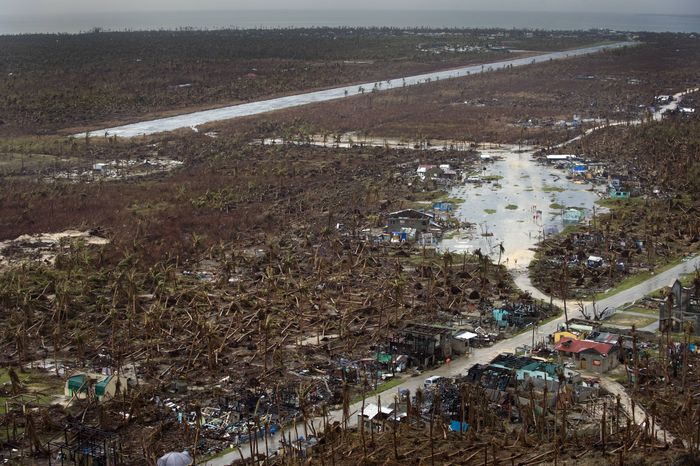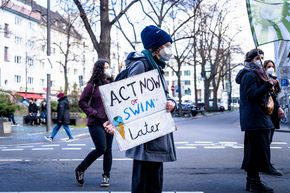As one of the most important challenges of the 21st century, the economic impacts of climate change will be felt all over the world. However, the vulnerability of jobs and incomes to weather related shocks is highest in those countries, which are strongly dependent on one single climate-sensitive sector such as tourism.
Many countries of the Global South are hit hard by climate change, as reflected in extreme weather events such as droughts, storms, and flooding, but also in gradual changes such as rising sea levels, melting glaciers and desertification. International tourism as an emitter contributes eight to eleven per cent to global warming. This is particularly due to air travel, which accounts for as much as four per cent of global warming, while 80 per cent of air travel is attributed to tourism. At the same time, the tourism sector is also a victim of climate change. It is directly affected, as its infrastructure is being destroyed, but also indirectly, as it relies on unspoilt natural and cultural sites.
Climate-related losses and damage jeopardise tourism revenues
This toxic interplay is visible in Asia, which is a continent on the frontlines of climate change and which is particularly vulnerable. Vietnam, Myanmar, Thailand, and the Philippines have been among the ten countries most affected by climate change over the past two decades. At the same time, tourism is one of Asia's most important sources of income and employment, contributing more than 20 per cent to the gross domestic product (GDP) in countries such as Cambodia, Thailand, and the Philippines. However, unabated climate change damages the ecological and cultural heritage of these countries and puts millions of livelihoods at risk – including those depending on tourism.
The global increase in temperatures and hazardous heat may increasingly deter tourists. This trend has already been observed in the Caribbean. Studies provide evidence of a negative correlation of this tropical destination’s vulnerability to climate change and its revenues from international tourism. For example, a ten per cent increase in vulnerability to climate change leads to a ten per cent decrease in tourism revenues’ contribution to GDP. At the same time, the costs due to climate change are extremely high: In the Caribbean, the costs of the damage caused by hurricane Maria in Dominica in 2017 amounted to as much as 260 per cent of the country’s GDP.
New fund addresses loss and damage
Given that climate-related losses directly and indirectly affect tourism, the fund for climate-related loss and damage – established at the last climate summit – should also be in the interest of the international tourism industry. For more than 30 years, the countries of the Global South – above all the small island developing states – had demanded financial support to cope with climate-related losses and damage.
The historic breakthrough for a new multilateral fund to support developing countries in handling climate-related losses and damage was achieved at the COP 27 UN climate conference in November 2022. One year later at the UN climate conference in Dubai, the fund for losses and damages was established on the opening day itself and financed during the two weeks of negotiations. In the future, the climate fund will address both economic and intangible losses and damage. Non-economic damage, such as the loss of homeland, culture, identity, or even human life, may not be measurable in monetary terms, but is very valuable nonetheless.
Industrialised countries do not pay enough for mitigation and adaptation
By the end of the COP28 in Dubai, the fund had been fed with USD 770.6 million. However, this is just about enough to establish the fund at the World Bank and make it operational, but far from sufficient to meet the actual needs. The industrialised countries have not made any commitment to pay into the fund and no funding target has been set. It is estimated that the funds, which have been pledged may cover merely 0.2 percent of what developing countries will need per year. However, in 2022 the climate-related damage in developing countries already amounted to around USD 109 billion and will continue to increase in the future. Experts estimate that by 2030 the annual damage in developing countries alone will amount to USD 400-580 billion.
At present, the 106 developing countries that are most seriously affected by the impacts of climate change bear most of the costs of climate-related losses and damage in their countries themselves. Still, the industrialised countries have not fulfilled their old promise of providing USD 100 billion annually in climate finance for mitigation and adaptation from 2020 onwards. That’s why in addition to conventional climate finance there are now more discussions on innovative sources of finance, applying the polluter-pays principle to cover the costs of climate-related losses and damage. The discussions have come to focus on a property tax, taxes and levies on emissions from aviation and shipping, and a carbon tax.
Climate financing by carbon tax?
At the last COP28 in Dubai, France and Kenya launched a Taskforce on International Taxation. Within two years, they want to submit proposals on how international carbon taxes can increase revenues to combat the climate crisis. A levy on emissions from aviation and shipping would have huge potential to provide climate financing and to contribute to climate justice. The so-called International Air Passenger Adaptation Levy (IAPAL) would include a levy on long-haul flights, amounting to USD 6 on economy tickets and USD 62 on business class tickets. Depending on how it is designed, this levy could generate eight to ten billion USD per year.
Polluter pays principle can successfully address losses and damage
However, the tourism sector would not be negatively affected by such a levy, which amounts to less than one per cent of the air fare. Such a low levy without emissions cap will not have any steering effect that would benefit mitigation. It is not expected that people would refrain from taking flights as a result. However, by applying the polluter pays principle, the necessary financial resources are being generated to deal with losses and damage caused by climate change.
However, in order to contribute to more climate justice, the tourism sector is called upon to do significantly more to prevent climate-related losses and damage by drastically reducing its own carbon emissions and by taking measures to adapt to climate change.
Sabine Minninger has been in charge of international climate politics at Bread for the World since 2012. Together with the Loss and Damage Collaboration, she campaigned for the fund to address climate-related losses and damage. Sabine Minninger was part of Bread for the World’s delegation at the COP 28 in Dubai. For 16 years, she has been involved in the climate negotiations together with partner organisations. From 2003 to 2012, she worked as a consultant for Tourism Watch.
Sources:
Smail, Evelyn (2023): Impact of Climate Change on Tourism, available online: https://www.climateimpactstracker.com/impact-of-climate-change-on-tourism/
UNFCCC (2023): Global Stocktake, COP28, Dubai
Cevik, Serhan; Ghazanchyan, Manuk (2020): IMF Working Paper: Perfect Storm: Climate Change and Tourism, available online: https://www.imf.org/en/Publications/WP/Issues/2020/11/13/Perfect-Storm-Climate-Change-and-Tourism-49828
Stamp out Poverty, Actionaid, Bread for the World, Heinrich Böll Foundation Washington D.C., Practical Action (2020): Unpacking finance for Loss and Damage. Lessons from Covid-19 for addressing loss and damage in vulnerable developing countries. https://us.boell.org/sites/default/files/2021-04/Unpacking%20finance%20paper%201%20%28final%29.pdf
Tourism Panel on Climate Change (2023). Tourism and Climate Change Stocktake 2023. Eds. Becken, Susanne; Scott, Daniel, available online: https://tpcc.info/





